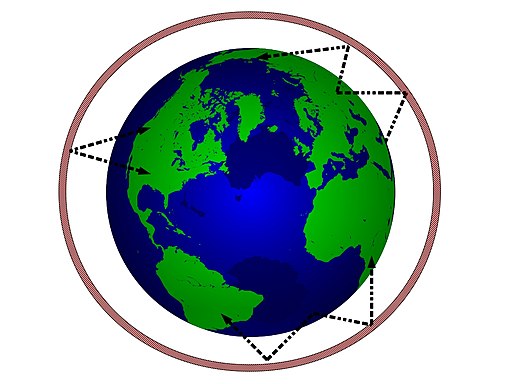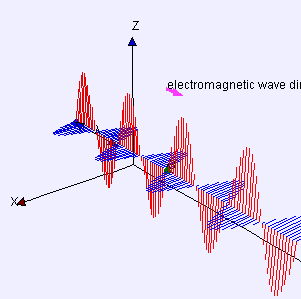Table of Contents
Introduction
The first radio transmission was conducted by Guglielmo Marconi in 1895. Since then, radio communication has been adopted for multiple applications that include human-to-human communication, human-to-machine communication and machine to machine communication. In this post we look at a specific band of frequencies called the High Frequency (HF) band and antennas that are used to transmit and receive signals in this band.
Before we get into the details let’s take a quick look at different antennas used for HF applications
- The G5RV antenna
- Multiband antennas
- HF loop antenna
Table of Contents
Radio Frequency Spectrum
The radio spectrum is that range of frequencies of the electromagnetic spectrum that is used for radio communications. The frequencies used for radio range from 30 Hz to 300 GHz.

Figure 1: Electromagnetic spectrum
Radio frequencies are regulated to prevent interference and unauthorized use. The FCC regulates radio frequencies in the US. Similarly, every country has a national regulator that regulates the use of radio frequencies within its borders.
The International Telecommunication Union (ITU) is an agency of the United National (UN). Its function is to coordinate telecommunications services and operations – including radio frequencies – throughout the world.
Relation of Frequency to Antenna Size
The frequency and wavelength of an electromagnetic wave are inversely proportional. The length of the antenna required for efficient propagation is directly proportional to the wavelength. Hence the length of the antenna required for efficient propagation varies inversely with the frequency that is used.
In other words, smaller antennas are required for higher frequencies and larger (longer) antennas are required for lower frequencies. The following table shows the antennas sizes required for some of the frequencies that we find in everyday use.
| Frequency band | Application | Antenna Size |
| HF / 3.5 MHz | Amateur radio / Air to ground etc | 137 feet |
| HF / 28 MHz | Amateur radio | 17 feet |
| VHF / 148 MHZ | FM radio, TV | 1 foot 7 inches |
| UHF | TV, Cellular Mobile | 2.5 to 25 cm |
| 2.4 GHz | Wi-Fi / Bluetooth | 3.1 cm |
HF frequencies are generally on lower side, and therefore require larger antennas in the range of 17 to 137 feet.
Relation of Frequency to Propagation Distance
Radio waves are attenuated and get weaker as they pass through free space. The attenuation of radio waves is directly proportional to the frequency used and the distance between transmitter and receiver.
This means that – provided other factors are kept constant – lower frequencies propagate further than higher frequencies.
The free-space path loss – when the transmitter and receiver have a clear, unobstructed line-of-sight (LOS) – is given by the following formula:
FSPL = 20*Log10(d) + 20*Log10(f) + Lc + 20*Log10(4π/c) – GTx – GRx
- f = frequency (GHz)
- d = LOS range between antennas (km).
This equation is used to calculate antenna range using this calculator.
The following table shows the free-space propagation loss vs distance for some of the frequencies that we find in everyday use.
| Distance (km) | Path Loss @ 30 MHz | Path Loss @ 700 MHz | Path Loss @ 5 GHz |
| 5 | 76 | 103 | 120 |
| 10 | 82 | 109 | 126 |
| 15 | 86 | 113 | 130 |
| 20 | 88 | 115 | 132 |
| 25 | 90 | 117 | 134 |
| 30 | 92 | 119 | 136 |
| 35 | 93 | 120 | 137 |
| 40 | 94 | 121 | 139 |
| 45 | 95 | 122 | 140 |
| 50 | 96 | 123 | 140 |
Table 2: Path loss vs Distance and Frequency
HF frequencies are generally on the lower side, and therefore are attenuated the least and propagate further.
The antenna gain GTx = GRx= 0
High-frequency or HF Band
The High-frequency or HF band of the radio frequency (RF) spectrum lies between the medium-frequency or MF band and the Very High Frequency or VHF band. The HF band is part of the shortwave (SW) band that extends from the HF band to the bottom part of the VHF band.
Frequency range
The range of frequencies allotted to the HF band by the ITU is 3 MHz to 30 MHz.
Propagation Characteristics of HF
Compared to VHF/UHF and other higher frequency bands, the HF frequency range is basically a lower range of frequencies that propagates relatively further. Let’s take a look at the different ways in which signals at these frequencies propagate.
Ground Wave Propagation
This mode of propagation refers to HF waves that travel along the surface of the Earth.

Skywave Propagation
The ionosphere is the ionized part of the upper atmosphere. It is so called because it is ionized by solar radiation and extends from about 48 km to 965 km.

The ionosphere refracts or bends incident HF radio waves back towards the Earth. This phenomenon allows the use of HF for beyond-the-horizon communication. HF links using skywave can span distances of up to 1900 miles or 3000 km.
Near Vertical Incidence Skywave (NVIS)
This propagation mode utilizes skywave propagation for ranges of up to 650 km. Vertical polarization is normally used for NVIS, whereas horizontal polarization is normally used for long-distance communication.
Applications of HF Communication
HF is used for a wide range of applications including:
- Amateur radio: used by hobbyists, outdoor enthusiasts, off-roaders etc.
- Military communication: used for long distance communication
- Ship-to-ship /ship-to-shore communication: up to 200 nautical miles via ground wave propagation during the daytime, and up to 400 nautical miles at night
- Air-to-ground communication: required for trans-oceanic flights
- Shortwave AM radio broadcast: listeners in America can tune into transmissions from Europe, Asia, and Australia
Antenna Types
Antennas can generally be classified into two types:
- Omni-directional – transmit RF power equally in all directions.
- Directional – transmit majority of the RF power in a particular desired direction, and a smaller portion of the RF power in other directions. The gain of the antenna is measure of its directivity. Antennas with higher gain transmit signals that are more focused as compared to antennas with lower gain.
Below we review some of the antennas that are used for HF communication.
G5RV antenna
The G5RV antenna is a popular HF antenna that can be used for HF communication with or without a transmatch/tuner.
A standard G5RV antenna that is 102 feet long can be used for 80 to 10 meter wavelengths. A half-length G5RV can be used for 40 to 10 meter wavelengths.
HF loop antenna
The HF loop antenna is an antenna that consists of a coil or loop or wire.
Antenna with larger loops have a perimeter that is near one wavelength and can be used for transmission and reception.
Antennas with small loops – aka magnetic loop antennas – have a perimeter that is smaller than one wavelength and are normally used for reception only. These antennae are called magnetic loops because they respond only to the magnetic field component of the electromagnetic waves. The reduced antenna size makes them portable. These antennas can also be used for reception for homes or apartments.
Rhombic Antenna
A Rhombic antenna is made of four sections of wire that are connected in the shape of a rhombus. It is a directional antenna that is suited to links that use skywave propagation for long-distance communication.

HF Yagi antenna
The Yagi-Uda or Yagi antenna was invented by two Japanese engineers. It is a directional antenna and is available for a wide range of frequency bands that include the HF band.
The antenna shown in the figure with transmit horizontally polarized waves. Rotating the antenna by 90 degrees will make it vertically polarized.
Multiband HF antenna
Multiband HF antennas are those that support multiple bands such as HF and VHF (30 MHz to 300 MHz). Multiband HF antennas are available for
Mobile HF antenna
Vehicles can accommodate antennae of limited lengths, and several Mobile HF antenna for vehicle mounting are available.
Please note that the actual length of the antenna shown is 72 inches or 6 feet.
Vertical HF antenna
Vertical HF antennas are suited to applications where the amount of available space is limited.
Frequently Asked Questions
What is the most effective HF antenna?
The most effective antenna will vary with the application:
- Users that require vehicle-mounted or portable antennas need smaller antennas, and therefore small loop antennas, vertically antennae, or antennae with similar dimensions would be preferable
- Users that use HF for long-distance communication might need to set up large rhombic antennas.
- Users that use HF for ground wave communication can use vertical antennas of suitable lengths.
What is the difference between a vertical and horizontal antenna – which one would you recommend for HF?
An electromagnetic wave is comprised of an electrical field and a magnetic field, and both fields are perpendicular to each other. The polarization of an electromagnetic wave refers to the electric field.
- A vertically-polarized antenna emits an electromagnetic wave with a vertical electric field (and a horizontal magnetic field).
- A horizontally-polarized antenna emits an electromagnetic wave with a horizontal electric field (and a vertical magnetic field).

Radio waves are attenuated as they pass through free space and when they pass through solid objects such as walls or foliage. Radio waves are also attenuated by rain. Rain attenuation has a comparatively lesser effect on vertically polarized electromagnetic waves, and for this reason most radio systems are deployed with vertical i.e. vertically polarized antennae.
However, the situation for HF is different because:
- Lower frequencies lead to larger antenna size requirements
- It is not practical to have hundreds of feet long vertical antennas
- It is much more practical to have large horizontal antennae such as rhombic antennas
- Another factor is that the ionosphere can change the polarization of signals that pass through it.
- Vertical polarization is normally used for NVIS, whereas horizontal polarization is normally used for long-distance communication.
The net result is that large HF antennae usually have horizontal polarization. Smaller ones that are deployed for ground wave communication can be vertically polarized.
Conclusion
The major benefits of HF i.e. long range and skywave propagation are the direct result of the band being comprised of relatively low frequencies.
Before the advent of satellite, HF was the primary means for long-distance wireless communication. Reliable satellite links led to HF being used for backup and disaster-recovery.
The development of Automatic Link Establishment or ALE technology has allowed the establishment of low-cost and reliable HF links and led to a resurgence in the use of HF for long-distance communication.
In addition to long-distance communication, HF is used for a wide range of applications that include AM radio, military use, ground to air communication, and amateur use.





